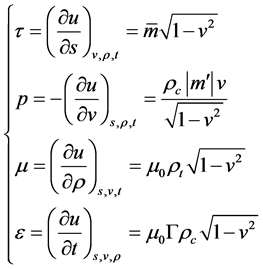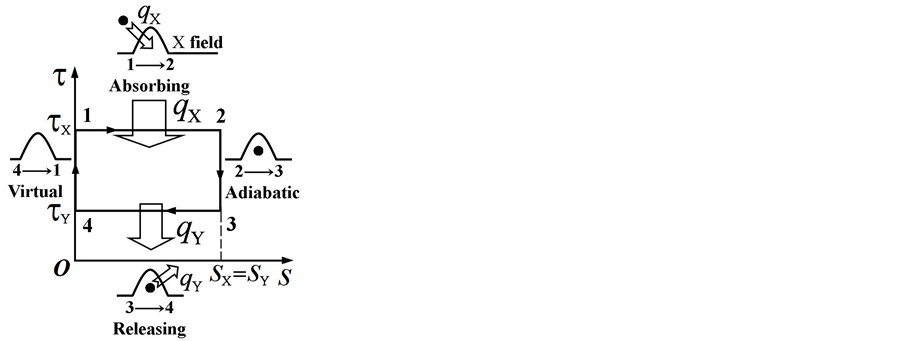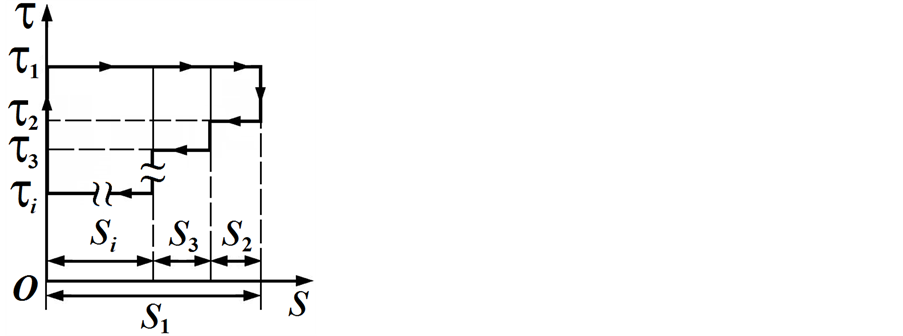Open Access Library Journal
Vol.02 No.05(2015), Article ID:68386,8 pages
10.4236/oalib.1101493
Particle Physics Can Be Investigated from a Thermodynamic Point of View
Qiankai Yao1,2
1School of Physical Engineering, Zhengzhou University, Zhengzhou, China
2College of Science, Henan University of Technology, Zhengzhou, China
Email: yaoqk@zzu.edu.cn
Copyright © 2015 by author and OALib.
This work is licensed under the Creative Commons Attribution International License (CC BY).
http://creativecommons.org/licenses/by/4.0/



Received 22 April 2015; accepted 7 May 2015; published 14 May 2015
ABSTRACT
Based on the idea of that particle decay represents nothing but a kind of thermodynamic process due to its spontaneity, we here explore a new kind of heat engine: particle Carnot engine (PCE), which satisfies Carnot’s theorem. The result shows that any single particle carries its quantized intrinsic entropy, and the total entropy never decreases for any decay process. Particle thermodynamic laws analogous to the usual ones are proposed, among which the momentum conservation principle is specially introduced that will determine the irreversibility of particle decay. Moreover, we also develop the operational definitions of particle state functions, including Boltz- mann relationship, which can be used to discuss the thermodynamic properties of particle objects. Thus, our study can provide a new theoretical framework to investigate particle physics.
Keywords:
Particle Decay, Particle Carnot Engine, Particle Thermodynamic Laws
Subject Areas: Particle Physics, Thermodynamics

1. Introduction
Through generalizing in some interdisciplinary areas [1] [2] , thermodynamics has successfully led to a series of new concepts, such as quantum heat engine (employing as working agents multi-level systems instead of gas-filled cylinders) [3] [4] , information entropy (an equivalence between information and entropy is postulated) [5] and quantum entanglement (in some way analogous to thermodynamic energy) [6] [7] . These concepts imposing the thermodynamic aspects of microscopic objects of interest, inspire us to study particle physics from a thermodynamic standpoint, and make us believe that a single particle could also exhibit its thermodynamic properties since it carries an intrinsic spin, spreads like a wave and acts as a complicated system. In this paper, we will give the basic elements of our analogy between particle physics and thermodynamics. To provide background for the details of the analogy, we propose the particle thermodynamic laws, and further develop the operational definitions of particle state functions to discuss the thermodynamic properties of particle objects.
2. Analogy between Particle Object and Thermodynamic System
To develop the full analogy between particle object and thermodynamic system, we need to recall that particle decay is exactly representing a kind of spontaneous process, just as heat passing from a higher to a lower temperature (the situation is shown as Table 1). So, we take notice of the thermodynamic meaning of particle object
with moving velocity , and treat its relativistic energy
, and treat its relativistic energy  (nature units:
(nature units:  adopted) as the enthalpy function
adopted) as the enthalpy function
 (1)
(1)
of which the differential reads
 (2)
(2)
here  denotes the mean value of mass
denotes the mean value of mass  with a distribution width
with a distribution width ,
,  is the intrinsic temperature of particle object, and
is the intrinsic temperature of particle object, and  is the intrinsic entropy with a quantized mean value of
is the intrinsic entropy with a quantized mean value of  (here called entron, i.e. quantum of entropy). Therefore, following from the above form, there also exist other functions in which one or more variables is replaced by its slope, the functions with the same information content can be obtained by applying the following transform. For example, a function defined by
(here called entron, i.e. quantum of entropy). Therefore, following from the above form, there also exist other functions in which one or more variables is replaced by its slope, the functions with the same information content can be obtained by applying the following transform. For example, a function defined by
 (3)
(3)
it yields the transition from independent variables  to
to , and then gives
, and then gives
 (4)
(4)
The differential above suggests that  may be treated as the internal energy of moving particle with the natural variables
may be treated as the internal energy of moving particle with the natural variables 



Now, let us imagine there is a particle 










the two heat reservoirs, with, in each cycle (called particle Carnot cycle), heat 




(i) Isothermal expansion of 



(ii) Emerging of 
(iii) Isothermal compression of 
field at




(iv) Breaking of thermal contact and continuance of adiabatic compression of 
In the way, PCE is made up, and all PCEs operating between the same two reservoirs have the same efficiency of converting bound energy to useful form, that is

Figure 1. Temperature-entropy diagram for particle Carnot cycle. In working process of the imagined PCE, the distribution of useful energy is completely determined by Carnot’s theorem.
Table 1. Natural symmetry suggests that a particle object should exhibit thermodynamic behaviors like a complicated system.
here the adiabatic case of 






livered, the efficiency of presented PCE should be zero, namely

Moreover, considering no engine more efficient than PCE, we have

This is referred to as Clausius’ inequality, in which, “=” is allowed only for reversible decay process (i.e.

ure 2). Importantly, inequality (7) can lead directly to the principle of increasing entropy for particle physics: in any decay process, the total entropy of relevant particles increases or remains constant, but cannot decrease. In particular, for 

the entropy increase trend can be shown as

Figure 2. Any reversible particle decay process of 


Thus we say it is the principle that determines the irreversibility of particle decay.
3. Particle Thermodynamic Laws
So far, based on the obtained above, we present the following particle thermodynamic laws.
0th law: Particle objects have well-defined values of some set of state variables, being of two types: to some extensive variables (such as



1st law: Energy is conserved for all particle processes. The law claims that the particle perpetual mobile of the first kind is absolutely impossible.
2nd law: Exactly as the usual one [12] , this law has two equivalent statements:
(i) Particle at lower temperature (corresponding to small mass) cannot decay spontaneously into the one at higher temperature (corresponding to a large mass); while the constraints on the system and the state of the rest of the world are left unchanged (analogous to Clausius’).
(ii) It is impossible to find a single particle that produces no effect other than the transformation of its bound energy into an equivalent amount of useful form (analogous to Kelvin’s).
In other word, the particle perpetual mobile of the second kind never occurs. The important point is here that, if allow a particle transform its bound energy directly into the useful form, namely

2.5th law: In any particle process, the total momentum cannot increase, nor decrease, but remains constant. As a supplementary item, such law puts restrictions on which processes may occur, or more particularly which processes can never occur even though they are allowed by the 2nd. For example, the decay process of 
3rd law: It is impossible to design a procedure that can control particle temperature to zero, namely, the absolute zero of particle is never attainable. This law disallows any decay process with 100% efficiency, even if for photon (with nonzero mass) [13] [14] , no exceptions are made.
4. State Functions
To set up the state functions of a decay particle of mass width



can determine a mass distribution in the following form

Combing with the decay function of

Such the result can help us to write the adjusted enthalpy function in the form of

followed by the internal energy

So that, the total differential of the function reads

with the identifications:

Obviously, 




Note that, the Maxwell relations for particle object are a consequence of the fact that the order of the cross derivatives of 

accompanied with the chemical potential 

These two are corresponding to the usual forms respectively

If further, apply Legendre transform to


including the variation of

The relationship enables us to explore an equilibrium criterion for an individual particle keeping contact with its surrounding bath







Now, consider a particle state with free energy
Figure 3. Log-log plot of chemical potential (



Table 2. The suggested analogies between thermodynamic system (TDS) and particle object (PO).

where 


Hence, to agree with Eq. (19) identifies

This is an analogue of Boltzmann relationship for particle physics, which can be made the basis of a theory of fluctuations about particle object in analogy to that of fluctuations about thermodynamic system. Specifically, the fluctuations in



where 



Note the stable particle condition of 


with a change ratio

equal to 



Finally, by the definition of particle temperature, we can further get the following relation

with 

5. Summary
Up to now, we have explored a new theory for the description of particle physics. And conceptually different from the conventional standpoint, this theory, by treating particle objects as a kind of thermodynamic system, has led to a number of apparently new results: (i) Particle decay behavior is restricted by Carnot’s theorem; (ii) There exist particle thermodynamic laws analogous to the usual ones. Especially, the momentum conservation principle is introduced to supplement the second law; (iii) Some thermodynamic functions, including an equilibrium criterion, are developed to describe particle states; (iv) Boltzmann relationship for particle physics is obtained. We here emphasize any microscopic particle in nature carries its intrinsic entropy with an absolute value near unit, and the total particle entropy never decreases for any decay process. It is important that we find a new route that can be followed to investigate particle physics in the mathematical framework of thermodynamics.
Cite this paper
Qiankai Yao, (2015) Particle Physics Can Be Investigated from a Thermodynamic Point of View. Open Access Library Journal,02,1-8. doi: 10.4236/oalib.1101493
References
- 1. Rumer, Y.B. and Ryvkin, M.S. (1980) Thermodynamics, Statistical Physics and Kinetics. Mir Publishers, Moscow.
- 2. http://pdg.lbl.gov/rpp/mcdata/mass_width_02.mc
- 3. Hagiwara, K., Hikasa, K., Nakamura, K., Tanabashi, M., Aguilar-Benitez, M., Amsler, C., et al. (2002) The Review of Particle Properties. Physical Review D, 66, Article ID: 010001.
http://dx.doi.org/10.1103/PhysRevD.66.010001 - 4. Goldberger, M. and Watson, K. (1964) Collision Theory. John Wiley, New York.
- 5. Joichi, I., Matsumoto, S. and Yoshimura, M. (1998) Time Evolution of Unstable Particle Decay Seen with Finite Resolution. Physical Review D, 58, Article ID: 045004.
http://dx.doi.org/10.1103/PhysRevD.58.045004 - 6. Borowski, P., Gemmer, J. and Mahler, G. (2003) On the Concept of Pressure in Quantum Mechanics. Europhysics Letters, 62, 629-635.
http://dx.doi.org/10.1209/epl/i2003-00420-8 - 7. Lévy, M. (1959) On the Description of Unstable Particles in Quantum Field Theory. Il Nuovo Cimento, 13, 115-143.
http://dx.doi.org/10.1007/BF02727534
Horwitz, L.P. (1995) The Unstable System in Relativistic Quantum Mechanics. Foundation of Physics, 25, 39-65.
http://dx.doi.org/10.1007/BF02054656 - 8. Lakes, R. (1998) Experimental Limits on the Photon Mass and Cosmic Magnetic Vector Potential. Physical Review Letters, 80, 1826-1829.
http://dx.doi.org/10.1103/PhysRevLett.80.1826 - 9. Barrow, J.D. and Burman, R.R. (1985) Particle Physics and Cosmology: New Light on Heavy Light. Nature, 307, 14-15.
http://dx.doi.org/10.1038/307014a0 - 10. Callen, H.B. (1985) Thermodynamics and an Introduction to Thermostatics. Wiley, New York.
- 11. Davies, E.B. (1976) Quantum Theory of Open Systems. Academic Press, New York.
- 12. Bernardini, C., Maiani, L. and Testa, M. (1993) Short-Time Behavior of Unstable Systems in Field Theory and Proton Decay. Physical Review Letters, 71, 2687-2690.
http://dx.doi.org/10.1103/PhysRevLett.71.2687 - 13. Benatti, F. and Floreanini, R. (1998) On the Decay Law for Unstable Open Systems. Physics Letters B, 428, 149-156.
http://dx.doi.org/10.1016/S0370-2693(98)00390-6 - 14. Garay, L.J. (1998) Spacetime Foam as a Quantum Thermal Bath. Physical Review Letters, 80, 2508-2511.
http://dx.doi.org/10.1103/PhysRevLett.80.2508 - 15. Vedral, V. and Kashefi, E. (2002) Uniqueness of the Entanglement Measure for Bipartite Pure States and Thermodynamics. Physical Review Letters, 89, Article ID: 037903.
http://dx.doi.org/10.1103/PhysRevLett.89.037903 - 16. Horodecki, P., Horodecki, R. and Horodecki, M. (1998) Entanglement and Thermodynamic Analogies. Acta Physica Slovaca, 48, 141-156.
- 17. Rohrlich, D. (2001) Thermodynamic Analogues in Quantum Information Theory. Optics and Spectroscopy, 91, 363-367.
http://dx.doi.org/10.1134/1.1405213 - 18. Scully, M.O., Zubairy, M.S., Agarwa, G.S. and Walther, H. (2003) Extracting Work from a Single Heat Bath via Vanishing Quantum Coherence. Science, 299, 862-864.
http://dx.doi.org/10.1126/science.1078955 - 19. Bender, C.M., Brody, D.C. and Meister, B.K. (2002) Entropy and Temperature of a Quantum Carnot Engine. Proceedings of the Royal Society of London A, 458, 1519-1526.
http://dx.doi.org/10.1098/rspa.2001.0928 - 20. Zubairy, M.S. (2002) In: Sheehan, D., Ed., Quantum Limits to the Second Law, AIP Press, New York, 91-97.
- 21. Scully, M. (2002) In: Sheehan, D., Ed., Quantum Limits to the Second Law, AIP Press, New York, 83-91.







